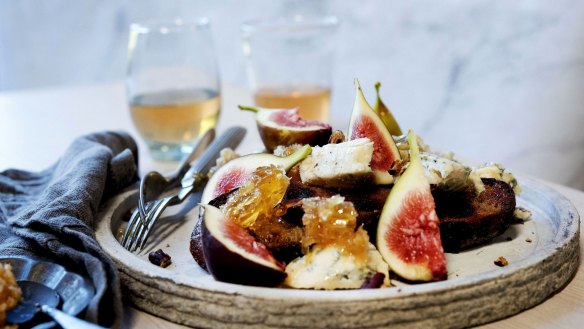Why ripe figs are so hard to find in shops

Why can't I buy ripe figs? P. May
With their crimson-hued flesh and curvy shape, figs are an ancient symbol of fertility. Few experiences are more sensual than plucking and eating a ripe fig from the tree on a warm day.
The fig is not technically a fruit but hundreds of tiny flowers encased in a bulbous stem. A small hole in the base of the fig allows tiny wasps to enter to pollinate the flowers.
Once pollinated, the flowers become tiny seeds; that's the crunch you get from eating ripe or dried figs. The swollen flesh – part of the stem – becomes naturally laden with fruit sugar, and the skin becomes more tender, a clever act to entice birds and mammals to eat and distribute the seed.
There are scores of different varieties. Some, like Green Zadar, are so thin-skinned they almost fall apart when picked, but are incredibly delicious.
Commercial figs are thicker-skinned varieties picked before they are truly ripe so they can handle transport and days sitting on a supermarket shelf.
While offering a sub-par eating experience, a little heat will soften them up and make them sweeter.
- Quarter them lengthwise, place in a baking tray, drizzle with scant olive oil and balsamic vinegar and bake at 140C fan-forced (160C conventional) for 30 minutes.
- Stuff with blue cheese and chopped walnuts and serve as a canape.
- Or cut figs in half lengthwise, place in a bowl and drizzle with oil and a little light honey and sprinkle with salt.
- Wrap in jamon, secure with a toothpick, and cook as above.
- Or cut, salt, oil, and dress in honey as before and lightly grill them, allow to cool, and serve on a cheeseboard.
I can't buy marjoram anymore. S. Cook
I know the feeling. I went to the stupidmarket, sorry, supermarket the other day to buy things like dried cannellini beans and risoni, only to be told they were now "deleted items". Marjoram's scientific name is Origanum majorana or Majorana hortensis.
That "hort" prefix indicates it is a horticultural plant, a more delicate version of its wild ancester, oregano. Grown since ancient times as a medicinal plant, it contains aromatic compounds borneol, camphor and pinene, plus limonene, which gives it a citrus note its wild cousin lacks.
Dried marjoram is often used in braised meat dishes while fresh leaves enliven vegetable recipes. Buy dried marjoram online at gewurzhaus.com.au or buy seeds from diggers.com.au. Plant in a pot in a sunny part of the garden or balcony.
How long has almond milk been around? K. Mann
Almonds have been pounded and added to soups, hot and cold, for millennia. Almonds arrived in Spain with the Moors in the 700s, and a cold, milky almond and garlic soup, ajo blanco, is still enjoyed in the south today. Almond milk became popular in medieval Europe in the 1200s and was used as a meat substitute on church-enforced fast days. Recipes from the 1300s call for meat to be soaked in almond milk. So almond milk is not new.
Send your culinary conundrums and ingredient suggestions to brainfood@richardcornish.com.au or Twitter and Insta @foodcornish.
- More:
- Food
- Brain food
